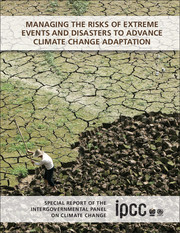 Managing the Risks of Extreme Events and Disasters to Advance Climate Change Adaptation
Managing the Risks of Extreme Events and Disasters to Advance Climate Change Adaptation Book contents
- Frontmatter
- Contents
- Section I
- Section II
- Section III
- Chapter 1 Climate Change: New Dimensions in Disaster Risk, Exposure, Vulnerability, and Resilience
- Chapter 2 Determinants of Risk: Exposure and Vulnerability
- Chapter 3 Changes in Climate Extremes and their Impacts on the Natural Physical Environment
- Chapter 4 Changes in Impacts of Climate Extremes: Human Systems and Ecosystems
- Chapter 5 Managing the Risks from Climate Extremes at the Local Level
- Chapter 6 National Systems for Managing the Risks from Climate Extremes and Disasters
- Chapter 7 Managing the Risks: International Level and Integration across Scales
- Chapter 8 Toward a Sustainable and Resilient Future
- Chapter 9 Case Studies
- Section IV
- Index
- References
Chapter 3 - Changes in Climate Extremes and their Impacts on the Natural Physical Environment
from Section III
Published online by Cambridge University Press: 05 August 2012
- Frontmatter
- Contents
- Section I
- Section II
- Section III
- Chapter 1 Climate Change: New Dimensions in Disaster Risk, Exposure, Vulnerability, and Resilience
- Chapter 2 Determinants of Risk: Exposure and Vulnerability
- Chapter 3 Changes in Climate Extremes and their Impacts on the Natural Physical Environment
- Chapter 4 Changes in Impacts of Climate Extremes: Human Systems and Ecosystems
- Chapter 5 Managing the Risks from Climate Extremes at the Local Level
- Chapter 6 National Systems for Managing the Risks from Climate Extremes and Disasters
- Chapter 7 Managing the Risks: International Level and Integration across Scales
- Chapter 8 Toward a Sustainable and Resilient Future
- Chapter 9 Case Studies
- Section IV
- Index
- References
Summary
Executive Summary
This chapter addresses changes in weather and climate events relevant to extreme impacts and disasters. An extreme (weather or climate) event is generally defined as the occurrence of a value of a weather or climate variable above (or below) a threshold value near the upper (or lower) ends (‘tails’) of the range of observed values of the variable. Some climate extremes (e.g., droughts, floods) may be the result of an accumulation of weather or climate events that are, individually, not extreme themselves (though their accumulation is extreme). As well, weather or climate events, even if not extreme in a statistical sense, can still lead to extreme conditions or impacts, either by crossing a critical threshold in a social, ecological, or physical system, or by occurring simultaneously with other events. A weather system such as a tropical cyclone can have an extreme impact, depending on where and when it approaches landfall, even if the specific cyclone is not extreme relative to other tropical cyclones. Conversely, not all extremes necessarily lead to serious impacts. [3.1]
Many weather and climate extremes are the result of natural climate variability (including phenomena such as El Niño), and natural decadal or multi-decadal variations in the climate provide the backdrop for anthropogenic climate changes. Even if there were no anthropogenic changes in climate, a wide variety of natural weather and climate extremes would still occur. [3.1]
A changing climate leads to changes in the frequency, intensity, spatial extent, duration, and timing of weather and climate extremes, and can result in unprecedented extremes. Changes in extremes can also be directly related to changes in mean climate, because mean future conditions in some variables are projected to lie within the tails of present-day conditions. Nevertheless, changes in extremes of a climate or weather variable are not always related in a simple way to changes in the mean of the same variable, and in some cases can be of opposite sign to a change in the mean of the variable. Changes in phenomena such as the El Nino-Southern Oscillation or monsoons could affect the frequency and intensity of extremes in several regions simultaneously. [3.1]
- Type
- Chapter
- Information
- Managing the Risks of Extreme Events and Disasters to Advance Climate Change AdaptationSpecial Report of the Intergovernmental Panel on Climate Change, pp. 109 - 230Publisher: Cambridge University PressPrint publication year: 2012
References
- 1022
- Cited by
